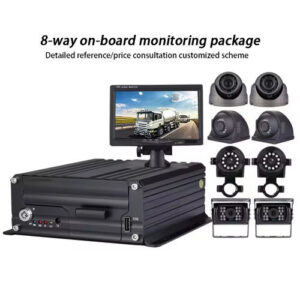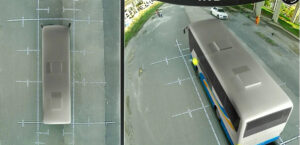In modern vehicles, safety is paramount—and technology continues to play a crucial role in achieving it. One such innovation is the Twin Lens Reversing Camera, which uses dual cameras to offer an expanded view of your vehicle’s rear surroundings. This article explores the technology behind twin-lens reversing cameras, their key features and benefits, and tips for choosing and installing one in your vehicle.
What Is a Twin Lens Reversing Camera?
A Twin Lens Reversing Camera system utilizes two cameras mounted on the rear of the vehicle, typically on either side of the license plate or bumper. Unlike traditional single-camera systems, the twin-lens design captures two distinct angles simultaneously. This dual perspective not only reduces blind spots but also provides drivers with a comprehensive view of obstacles on both sides when reversing.
For further insights into automotive safety technologies, visit the National Highway Traffic Safety Administration (NHTSA), which provides detailed resources on vehicle safety standards and innovative safety solutions.
Key Features of a Twin Lens Reversing Camera
1. Dual-View Coverage
The primary advantage of a twin-lens system is its ability to capture images from two separate angles. This dual-view setup ensures that drivers receive a panoramic view of the rear area, making it easier to detect obstacles, pedestrians, and other vehicles that might be missed by a single-camera system.
2. High-Definition Imaging
Many twin-lens reversing cameras offer high-definition (HD) recording, ensuring clear and sharp images regardless of the lighting conditions. Features such as wide dynamic range (WDR) and low-light enhancement further improve visibility during nighttime or challenging weather conditions.
3. Wide-Angle Lens
Wide-angle lenses in twin lens systems help cover a broader field of view, capturing more of the vehicle’s surroundings. This is particularly useful in crowded parking lots or tight urban settings, where every angle matters.
4. Integrated Guidelines and Overlays
Advanced models often come with on-screen guidelines and distance markers that assist drivers in judging space and distance while reversing. These overlays can be crucial for avoiding obstacles and ensuring a safe, precise maneuver.
5. Seamless Integration with Vehicle Displays
Modern twin-lens reversing cameras are designed for easy integration with existing infotainment or rear-view display systems. This integration allows for real-time video feeds and intuitive controls, enhancing the overall user experience.
For expert reviews and additional technical specifications, check out Consumer Reports’ automotive section, which often features detailed analyses of in-car safety technologies.
Benefits of Using a Twin Lens Reversing Camera
Enhanced Safety
By providing a comprehensive dual view of the rear, the twin lens system significantly reduces blind spots. This expanded view allows drivers to react more quickly to obstacles, thereby reducing the risk of collisions during reversing maneuvers.
Improved Parking Assistance
Navigating tight parking spaces becomes easier when drivers have access to real-time, multi-angle views of their surroundings. The combination of high-definition video and integrated guidelines helps in accurately assessing distance, thus minimizing parking-related mishaps.
Accurate Incident Documentation
In the unfortunate event of an accident, a twin-lens reversing camera can capture clear, multi-angle footage of the incident. This evidence is invaluable for insurance claims, legal proceedings, and accident reconstruction.
User-Friendly Experience
With easy installation and seamless integration into your vehicle’s existing system, twin-lens reversing cameras offer an intuitive user experience. The clear display and useful overlays ensure that even novice drivers can benefit from enhanced visibility and safety.
How to Choose the Right Twin Lens Reversing Camera
When selecting a twin-lens reversing camera for your vehicle, consider the following factors:
1. Video Quality
- Resolution: Look for systems offering at least 1080p resolution to ensure clear image quality.
- Low-Light Performance: Choose a model with strong low-light capabilities or infrared features for nighttime visibility.
2. Field of View
- Wide-Angle Lenses: Ensure the cameras have wide-angle lenses to capture as much of the rear area as possible.
- Adjustable Settings: Some systems allow for customization of the field of view, enabling you to tailor the camera angles to your specific needs.
3. Integration and Compatibility
- Display Compatibility: Verify that the camera system integrates seamlessly with your vehicle’s existing display unit or infotainment system.
- Ease of Installation: Look for products that come with clear instructions or professional installation options to ensure optimal placement and wiring.
4. Additional Features
- On-Screen Guidelines: Consider models that offer distance markers or parking guides.
- Durability: Choose cameras with a robust design that can withstand varying weather conditions and vibrations.
Installation & Maintenance Tips
Installation Best Practices
- Optimal Placement: Mount the cameras on the rear bumper or near the license plate where they can cover both sides effectively.
- Secure Mounting: Ensure that the cameras are securely attached to avoid misalignment due to vibrations or impacts.
- Professional Installation: If unsure, consider professional installation services to guarantee proper setup and system integration.
For a comprehensive guide on installing reversing cameras, refer to wikiHow’s dashcam installation guide.
Regular Maintenance
- Routine Checks: Periodically inspect the camera lenses and wiring to ensure they remain free of dirt and damage.
- Firmware Updates: Keep the camera’s firmware up to date to benefit from the latest features and security enhancements.
- Clean the Lenses: Regularly clean the lenses to maintain image clarity and optimal performance.
Conclusion
A Twin Lens Reversing Camera is a game-changing innovation for vehicle safety, offering enhanced rear visibility through dual-view coverage. By eliminating blind spots and providing high-definition images, this technology not only assists in safe reversing and parking but also documents critical incidents accurately.
When selecting a twin lens reversing camera, prioritize video quality, a wide field of view, seamless integration, and additional features like on-screen guidelines. For more authoritative insights into vehicle safety technologies, be sure to visit resources like the NHTSA and Consumer Reports.
Investing in a high-quality twin-lens reversing camera is a proactive step toward safer driving, greater peace of mind, and enhanced overall vehicle security.






